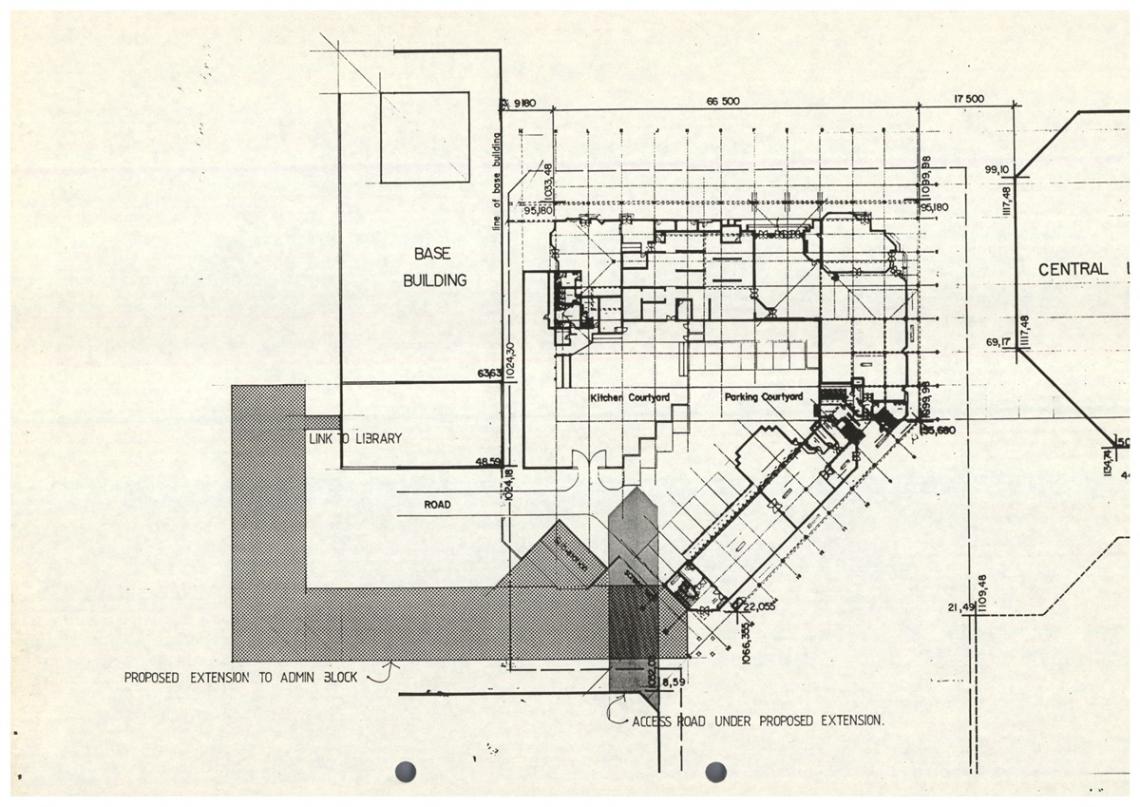- The Base Building was the first building on the campus of North-West University, Mahikeng. This was in the late 1970s, and the fledgling campus was then described as a dry, drab building site.
-
Construction of the Base Building—the first structure to physically represent UNIBO—had already started when the University of Bophuthatswana opened its doors in January 1980. Initially, the university made use of temporary accommodation above a hardware store in Mmabatho.
-
In November 1980, the Base Building was completed. It was described as a curiously shaped pyramid or ziggurat, providing lecture rooms and staff offices.
-
The first phase of the Base Building was built for R2,077,456. In 1984, the second phase cost R1,688,932. This was completed well within the programme, by October 1985.
First Student Cafeteria
-
The first student cafeteria and administration block was an extension of the Base Building.
-
Construction of the student cafeteria started on 9 February 1984, with a budget of R1,190,000. The tender was awarded to Grinaker Construction. Total costs amounted to R3,067,942.
-
The building was handed over to the university in November 1984, and meals were already being prepared there by January 1985. At this time, the installation of telephones, furniture, and other fixtures was still underway and expected to be completed by the end of February.

The extensions to the administration block, or Base Building, as envisioned in the mid-to-late 1980s. It included a student cafeteria and facilities for the Fine Arts Faculty.
A Central Refectory Building Needed
-
Shortly after the completion of the Student Cafeteria in 1985, the Council appointed the architectural firm Pearse, Aneck Hahn, Donaldson & Whyte to design a Central Refectory, among other facilities.
-
On 23 February 1989, the Building Committee noted that, in terms of SAPSE, there was no justification for the construction of additional catering facilities in the foreseeable future. A report on the matter indicated an over-provision of space well beyond 1994.
-
A few months later, the Committee noted that:
-
The initial request for a Central Refectory was based more on student numbers than anything else. The project had since been discussed with the Development Bank of Southern Africa, and a survey had been conducted on the use of the present Refectory. The Academic Planner was to arrange a meeting with the bank.
-
Students previously paid a fee to have meals in the cafeteria, but numerous problems led to the discontinuation of this arrangement. Since there were eating facilities in the vicinity of the university, students were free to have their meals where they wished.
-
Given that there were 750 students in the residences while available catering facilities could only accommodate 250 students, it was felt that a central refectory was needed to cater for all students.
-
-
It was resolved that a sub-committee would investigate the issue. The construction of a separate student refectory occurred much later.
-
The current Student Centre was completed in 2010. It caters for numerous activities and includes a cafeteria, a career centre, CV-writing assistance, and a printing shop.
Enlargement of Base Building Necessary
-
According to the minutes of the Building Committee on 21 August 1985, Pearse, Aneck Hahn, Donaldson & Whyte were also appointed as architects to design additional enlargements of the Base Building, which became necessary.
-
Total costs amounted to just over R3 million, and the commencement date of the contract was February 1984. The contract period was 40 weeks. These extensions to the Administration Building were designated for the Fine Arts Faculty.
-
The estimated total budget was R2,776,632.
-
The Building Committee noted in October 1985 that the project had been practically completed.
-
In 1986, the School of Education was allocated a portion of the Base Building but also utilised a new building. At the time, re-planning of the Base Building took place.
-
Space then became available in the Base Building for education workshops, including a microteaching laboratory, a language laboratory, a special English library, and a workroom.
-
Heavy rain soon revealed gaps in the roof, requiring significant time and money for repairs. By 1989, it became necessary to install external cladding. The previous year, flooding had occurred in the building, necessitating urgent repairs to prevent future incidents.
-
In 1990, roof leaks in the Base Building were repaired at a tender price of R141,874, with a request for a five-year guarantee.
-
In 1992, the K Block of the Base Building was refurbished to house the Department of Fine Arts. Building work, costing approximately R280,000, was completed by August, and the department had already moved in.
-
Before the construction of the current Library Building, the Base Building served as the library. Many still refer to it as the "Old Library."
-
On 28 March 2002, a memo was sent by the Manager of Operations to the Chairman of the Building Committee, stating:
"In terms of the Occupational Health and Safety Act 85 of 1993... any multi-storey building should be provided with a means to convey person/s from one level to another, even if stairs are provided.
Since the erection of the Main Administration Building some two decades ago, no lift/elevator was installed to conform to the above Act. It is now a legal requirement, as per the Act, that an employer or owner of a building of this nature must provide both able-bodied persons and physically challenged or disabled persons with a means of conveyance in such a building.
-
A consulting electrical and mechanical engineering firm quoted R719,340 for the installation of a passenger lift with a 10-person capacity, a 900 mm-wide entrance, accessibility for physically challenged persons, and facilities for visually impaired persons. The lift was subsequently installed.
-
The Base Building currently houses lecture halls, the Graduate School of Business and Government Leadership, and the general computer lab.

A photograph of the Base Building with a sketch of the planned placement of the new lift.
